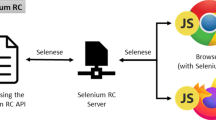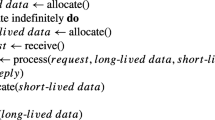Abstract
State-based object-oriented programming combines basic advantages of object-oriented and automata-based programming technologies. Its basic features are flexibility, extensibility, and powerful mechanism of description of complex behavior, which is based on finite automata. The disadvantage of the state-based object-oriented programming is the lack of standard methods for designing and implementing state-based classes. In this work, graphical notation for designing state-based classes, which combines capabilities of the class diagrams of the object-oriented programming and behavior diagrams of the automata-based programming, is presented. The proposed graphical notation makes it possible to generalize, decompose, structure, and incrementally extend logic of the state-based classes by means of the inheritance.
Similar content being viewed by others
References
Harel, D. and Pnueli, A., On the Development of Reactive Systems, Logic and Models of Concurrent Systems. Nato Advanced Study Institute on Logic and Models for Verification and Specification of Concurrent Systems, Springer, 1985, pp. 477–498.
Shalyto, A.A. and Tukkel’, N.I., From Turing Programming to Automaton Programming, Mir PK, 2002, no. 2, pp. 144–149, http://is.ifmo.ru/works/turing/.
Shalyto, A.A. and Tukkel’, N.I., SWITCH-technology: An Automated Approach to Developing Software for Reactive Systems, Programmirovanie, 2001, no. 5, pp. 45–62 [Programming Comput. Software (Engl. Transl.), 2001, vol. 27, no. 5, pp. 260–276].
Gamma, E., Khelm, R., Johnson, R., and Vlissides, J., Methods of Objective-Oriented Projection. Design Pattems, St. Petersburg: Piter, 2001, p. 368.
Adamczyk, P., The Anthology of the Finite State Machine Design Patterns, The 10th Conf. on Pattern Languages of Programs, 2003, http://hillside.net/plop/plop2003/Papers/Adamczyk-State-Machine.pdf.
Shalyto, A.A. and Naumov, L.A., Methods of Objective-Oriented Implementation of Reactive Agents on the Basis of the Finte Automata, Iskusstvennyi intellect, 2004, no. 4, pp. 756–762, http://is.ifmo.ru/works/_aut_oop.pdf.
Adamczyk, P., Selected Patterns for Implementing Finite State Machines, The 11th Conf. on Pattern Languages of Programs, 2004, http://pinky.cs.uiuc.edu/:_padamczy/docs/fsm_updated.pdf.
Odrowski, J. and Sogaard, P., Pattern Integration—Variations of State, Proc. of PLoP96, http://www.cs.wustl.edu/:_schmidt/PLoP-96/od-rowski.ps.gz.
Harel, D., Statecharts: A Visual Formalism for Complex Systems, Sci. Comput. Program, 1987, vol. 8, pp. 231–274.
Automata Studies, Princeton: Princeton Univ. Press, 1956.
Harel, D. and Naamad, A., The Statemate Semantics of Statecharts, ACM Trans. Softw. Eng. Methodology, 1996, vol. 5, pp. 293–333.
Mikk, E., Lakhnech, Y., Petersohn, C., and Siegel, M., On Formal Semantics of Statecharts as Supported by STATEMATE, Proc. of the 2nd BCS-FACS Northern Formal Methods Workshop, Ilkley, 1997.
Specification and Description Language (SDL), Int. Engineering Consortium, http://www.iec.org/acrobat.asp?filecode=125.
Benveniste, A., The Synchronous Languages 12 Years Later, Proc. of the IEEE, 2003, vol. 91, no. 1, pp. 64–83. http://www-sop.inria.fr/aoste/benveniste2003synchro nous.pdf.
André, C., SyncCharts: A Visual Representation of Reactive Behaviors, Tech. Report RR 95-52. I3S, Sophia-Antipolis, 1995.
Shalyto, A.A. and Tukkel’, N.I., Tanks and Automata, BYTE, Russia, 2003, no. 2, pp. 69–73, http://is.ifmo.ru/works/tanks_new/.
Shalyto, A.A., SWITCH-technology, Algoritmizatsiya i programmirovanie zadach logicheskogo upravleniya (Algorithmization and Programming of Logic Control Problems), St. Petersburg: Nauka, 1998, no. 1, p. 628.
Danforth, S. and Tomlinson, C., Type Theories and Object-Oriented Programming, ACM Comput. Surv., 1988, no. 1, pp. 29–72.
Sane, A. and Campbell, R., Object-Oriented State Machines: Subclassing, Composition, Delegation, and Genericity, OOPSLA’95, http://choices.cs.uiuc.edu/sane/home.html.
Lee, J., Xue, N., and Kuei, T., A Note on State Modeling Through Inheritance, SIGSOFT Softw. Eng. Notes, 1998, no. 1, pp. 104–110.
Taivalsaari, A., On the Notion of Inheritance, ACM Comput. Surv., 1996, no. 3, pp. 438–479.
Bracha, G. and Cook, W., Mixin-based Inheritance, OOPSLA/ECOOP’90, Conf. Proc., ACM SIGPLAN Not., 1990, no. 10, pp. 303–311.
Wegner, P. and Zdonik, S., Inheritance As an Incremental Modification Mechanism or What Like Is and Isn’t Like, ECOOP’88 Conf. Proc., Springer, 1988, pp. 55–77.
Shalyto, A.A. and Tukkel’, N.I., Implementation of Automata in Programming of Event Systems, Programmist, 2002, no. 4, pp. 74–80, http://is.ifmo.ru/works/evsys/.
Buch, G., Rambo, J., and Jacobson, A., UML. Rukovodstvo pol’zovatelya (UML. Guidance for a User), Moscow: DMK, 2000, p. 432.
Zayakin, E.A. and Shalyto, A.A., Method of Elimination of Repeated Code Fragments in Implementation of Finite Automata, Mir PK (CD), 2005, no. 8, http://is.ifmo.ru/projects/life_app/.
Shopyrin, D.G., Objective-Oriented Implementation of Finite Automata on the Basis of Virtual Methods, Informatsionno-upravlyayushchie sistemy, 2005, no. 3, pp. 36–40, http://is.ifmo.ru/works/runewstate/.
Shopyrin, D.G., A Method of Design and Implementation of Finite Automata on the Basis of Virtual Embedded Classes, Informatsionnye tekhnologii modelirovaniya i upravleniya, 2005, no. 1, pp. 87–97, http://is.ifmo.ru/works/ruvstate/.
Author information
Authors and Affiliations
Corresponding author
Additional information
Original Russian Text © D.G. Shopyrin, A.A. Shalyto, 2007, published in Programmirovanie, 2007, Vol. 33, No. 5.
Rights and permissions
About this article
Cite this article
Shopyrin, D.G., Shalyto, A.A. Graphical inheritance notation for state-based classes. Program Comput Soft 33, 283–292 (2007). https://doi.org/10.1134/S0361768807050040
Received:
Issue Date:
DOI: https://doi.org/10.1134/S0361768807050040




